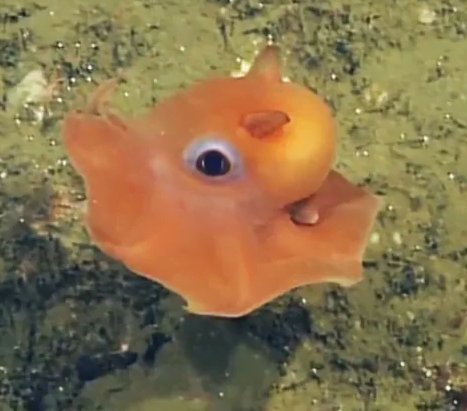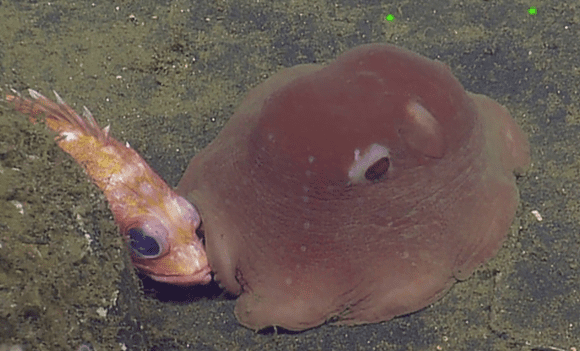The flapjack octopus is possibly the prettiest sea creature with a small and compact body. There’s not much information about these mysterious animals because they inhabit the deep ocean. This makes them even more appealing to both scientists and artists. Let’s find out more about flapjack octopus facts to know what’s interesting about these species.
Phylum: Mollusca
Class: Cephalopoda
Order: Octopoda
Genus: Opisthoteuthis
1. Flapjack octopus is the cutest species in the ocean
There are about 300 different varieties of octopuses on the planet, and the flapjack octopus is the cutest one. Compared to the other octopus species, the flapjack octopus is quite small with a maximum length is 20 cm (8 in). The other octopus species range in size from 30 – 91 cm (12 – 13 in). The females are slightly smaller than the males.
As a member of the Umbrella Octopus family, these creatures have webbing between their arms. This feature gives them the appearance of umbrellas. When they need to float safely to the sea bottom, they stretch their arms, and the webbing will slow them down.
Although the flapjack octopus has a smaller size than the other octopus species, it still owns bigger protruding eyes. Their eyes are kidney-shaped and pop out of the socket. This characteristic makes their staring gaze scary to most aquatic species.

To know more about the top cutest species in the world, you may read some of the articles below:
The animal comes with two flappy features on the top of their mantles, right over their eyes. Those are their fins, not their ears, and they have 2 functions. The first role is to make the octopus cuter and the second one is to help the octopus swim.
Fins are not found in all octopus species. As a result, the flapjack octopus’ fins separate it from other species. This cute creature has eight tentacles that are joined and attached together to create the umbrella shape. Each tentacle has a single row of suckers.
2. They’re named after the ability to flatten themselves
This species was discovered quite recently. Samuel Stillman Berry, an American marine zoologist, discovered the flapjack octopus species in 1949. Their scientific name is Opisthoteuthis Californiana and their common name is flapjack octopus. Because it can flatten itself out like a pancake or a flapjack, the species is named so.

This animal is so adorable that people insisted on renaming its name to “Opisthoteuthis Adorabilis” and making many kids’ accessories based on the animal, such as flapjack octopus soft toys, stuffed animals, sketchbooks, etc.
3. They don’t have ink
Unlike other octopus species, the flapjack octopus doesn’t have ink, camouflage ability, or a radula.
– To protect themselves, the majority of octopuses have ink sacs. They can expel an ink-like material when threatened. This confuses the predator and allows them to flee. However, the flapjack lacks this feature. This can be because they stay in the deep water, where seeing the ink would be nearly impossible.

– These creatures don’t have patterns or don’t change colors either. Their bodies have a gelatinous feel with translucent skin and come in three colors: red, pinkish, and yellow-orangeish. Since they are unable to alter the hue or texture of their skin, they can’t camouflage to hide from predators.
– Radula is found in the majority of octopuses. A radula is a sharp instrument featured in an octopus’ mouth. They scrape their meal with the radula to make it easier to consume. Flapjack octopuses lack this characteristic.
4. Habitat
Deep in the ocean where there is little light is the place the flapjack octopus prefers to live. The young octopus dwell 200 meters below sea level, whereas the adult prefer to travel considerably deeper. Their habitat extends in depth from 500 to 1500 meters.

The majority of them are found off the shores of Japan and California. They can also be found from the Bering Sea to the Sea of Okhotsk, along the island of Honshu in the northwestern Pacific, to southern California in the northeastern Pacific Ocean.
Even though the flapjack octopus can swim, they prefer to stay near the seafloor. Most of the time, they stay in the sea bed, resting in the soft mud. The creatures are also found near rocks, where they get food.
5. Flapjack octopuses vs Dumbo octopuses
Technically, there is no distinction between dumbo octopuses and flapjack octopuses. The term “Dumbo” octopus refers to a whole genus of deep-sea umbrella octopuses. Dumbo octopuses are all flapjack octopuses, but not all flapjack octopuses are dumbo octopuses.

Because of their huge, ear-like fins at the top of their mantle, they are called “dumbo”, just like the Dumbo elephant with huge ears of the Disney.
There are 15 known species of dumbo octopuses. They can be found in the deeper ocean than any other type of octopus. Some species can live as deep as 4,000m (13,100 feet).
6. They have fascinating movements
Even though being the octopus, the flapjack has its one-of-a-kind movements. They move through the ocean by using their fins and pulsating their small webbed arms. They can use funnels to generate jet propulsion that pushes them ahead in the water. Sometimes, they can utilize all three of the procedures above at the same time to move.
Because these cute species are not good swimmers, they will drift down slightly to the sea bottom after a brief swim. When they drift, their whole bodies expand like an umbrella. It’s fascinating to see a flapjack octopus move.
Living in the deep sea, the flapjack octopuses barely contact humans. If they do, they pose no threat to us. They are too small to cause serious harm to humans. The majority of the experts believe that these little critters are really cute and sweet, and harmless. But this doesn’t mean that you can buy a flapjack octopus and have them as pet.
Because these adorable species live at deeper depths in the sea, they do not perform well in water lower than 300 meters. You can’t get that kind of water for the tank at home. It is recommended to leave these species in their natural habitats. Another issue with keeping flapjack octopuses as pets is that there is not much information about them.
7. They’re fearsome hunters
The Flapjack octopus is carnivorous. Their diets mainly include small fish, crayfish, crabs, woodlice, shrimps, polychaete worms, plankton, krill, lobsters, prawns, barnacles, and other crustaceans.
Although having a cute look, the flapjack octopus is still a dangerous predator. They catch the prey, tear into them with their sharp beaks, and eat them. Their food is mostly in the mud and rocks on the seabed.
To forage for food, the octopuses use their arm to poke about in the mud. They then pick up the prey with their cirri and sucker discs. Cirri are finger-like threads that octopuses use to grab food.

They may also whip their arms in an attempt to stir up the sediment. Because octopuses have webbed arms, this works extremely well. Those arms create currents to move about the dirt.
Their best hunting strategy is to make themselves harmless to the prey. They do this by flattening themselves down, and when the target is on spot, they will attack them.
This is why they are known as “flapjack.”
8. They become visible to hide predators
Due to the lack of data, we don’t know much about animals that prey on these adorable organisms. However, researchers believe that they can be eaten by some predators like large fishes, whales, sperm whales, sharks, and fur seals.
The flapjack octopus doesn’t have an ink sac, that’s why they are more vulnerable to predators. However, they have their own ways to defend themselves against predators.
– They become invisible: The flapjack octopus cannot camouflage itself. Instead, they remain hidden in plain view. Contrary to your belief that the red and orange colors will stand out on the dark theme, red wavelengths can’t penetrate the deep ocean. As a result, the flapjack seems practically invisible to any predators nearby.

– Thanks to their small size, they can easily hide under sea rocks or cracks.
– They swim fast: When a predator comes too close, it will flee by pushing itself through the water. As mentioned above, this octopus has a funnel that shoots water out like a jet. They will then use their fins to direct themselves into a current. The current will carry them away from their enemy.
– Scary look: The flapjack octopus’ eyes are round, prominent, and bovine-like; while its fins resemble ears. This gives them the appearance of a gazing face, which scares their opponents, particularly chance predators.
9. Reproduction
In the breeding season, the male will do different sexual rituals to attract possible female companions. When the females agree, they begin to copulate.
During the intercourse procedure, the males grip the females tightly and put their hectocotylus into the mantle cavity (the primary feature of a mollusc), where the females are usually fertilized. The hectocotylus is the males’ modified arm which is used to deliver sperm into females.
Because the deep sea is so wide, the flapjack octopuses seldom meet their own species. That’s why they have evolved features that boost the chance of successful reproduction.

– Females are always carrying their eggs. The phases of development of the eggs differ. In this manner, when she bumps into a male, she will always have eggs ready for fertilization.
– The female occasionally receives sperm packets from the male. This packet will be stored safely till she is willing to fertilize her eggs or the environmental conditions are favorable.
Female flapjack octopuses can lay anywhere from 200 to 500 eggs at the ocean bed. The mother will affix the eggs to nearby rocks or other hard objects. After hatching, the baby or juvenile octopuses will dwell with their mother for a very brief period before growing large enough to survive on their own.

When the young flapjack octopuses are on their own ways, the mother goes back to her natural habitat. It’s also believed that the females die right after the eggs hatch, whereas the males die soon after mating season.
The species’ exact lifespan has yet to be confirmed. They are estimated to live between 1.4 and 2.6 years.

